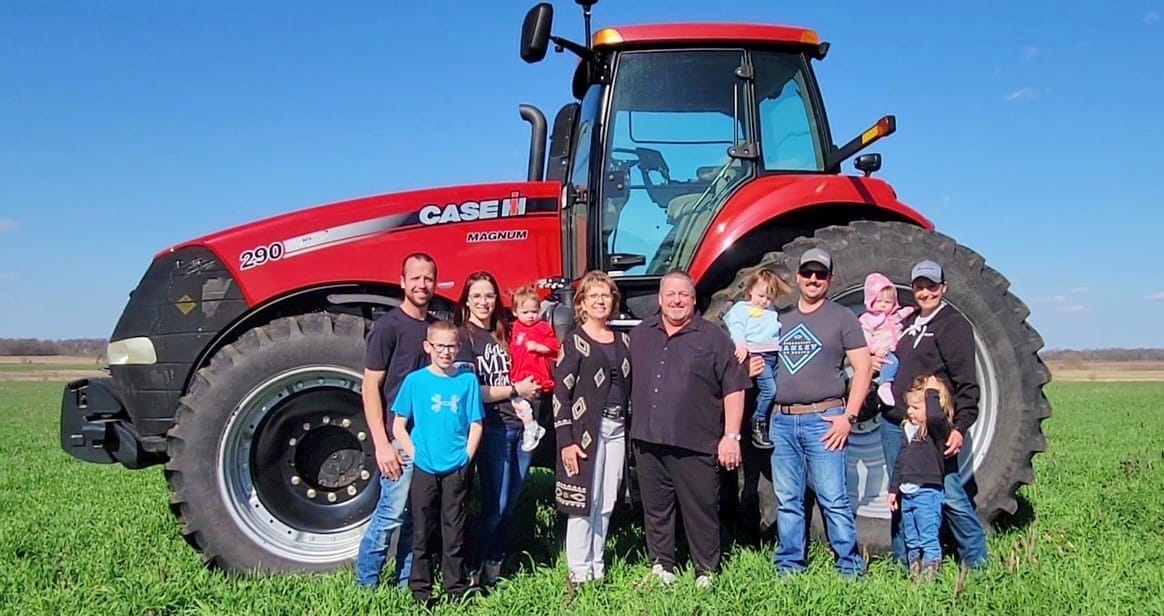Practical Cover Cropper: A Year in Review 2024
2024 was a year of research and field days. As we move forward to another year in cover cropping, let’s review the research and field days that happened in 2024.
May 2024: Michael Vittetoe
Roller-crimping a cereal rye cover crop for soybean production provides non-chemical weed control, but often with the caveat of delayed soybean planting dates. Looking for a way to plant soybeans earlier while reaping the benefits of a roller-crimped cereal rye cover crop, Michael Vittetoe of Washington, Iowa, began experimenting with in-row rolling a few years ago.
Michael’s system consists of a 10-inch, twin-row cereal rye cover crop growing between 30-inch spaced soybeans. With this system, he’s able to plant his soybeans at the end of April. In early June, he uses in-row roller units on a 40-foot bar to roll the cereal rye down to provide a moisture-conserving, weed-suppressing mulch.
“By having the soybeans shaded early and then giving them full sunlight you get more branching which creates more nodes, the nodes create more beans, and more beans create more revenue for our operation,” Michael says.
In this video recorded in 2022, you’ll hear why this system works for him and the benefits he sees to his soybean crop with the rolled cereal rye.
July 2024: Al and Kurtis Kadolph
In June, PFI visited the Kadolph family farm to hear from father and son farming team Al and Kurtis Kadolph about their use of cover crops and edge of field conservation practices on their farm. They use cover crops on all their acres with the goal of improving weed control and building soil health.
At the field day, they showed their equipment for planting cover crops in the fall and into cover crops in the spring. They showcased their Case IH Precision 550T no-till drill and Case IH 2150 planter set-up for no-till into cover crops with in-furrow starter fertilizer.
Al and Kurtis also discussed cover cropping ahead of corn, specifically for corn-on-corn rotations. “We’ve put a higher rate of triticale in our corn-on-corn fields, or anything that goes to corn, and a little bit of oats, camelina and some other stuff. We still put a little cereal rye out there because we want that biomass,” said Al. They advise using a cover crop mix ahead of corn and trying the mix on a few acres to test it if you’re just getting started. They bought their cover crops pre-mixed and planted them with their no-till drill.
With their cover crops and no-till, Al and Kurtis have noticed better water infiltration and water holding capacity which allowed them to get into their fields earlier than they otherwise would have with the wet spring.
August 2024: Alex and Krissy Udermann
Alex and Krissy Udermann own and operate Meadowbrook Dairy near Sartell, Minnesota, alongside Alex’s father, John, and brother, Jake. Their farm includes a 1,000-acre no-till row crop operation, along with 80 dairy cows and 300 beef steers. They also grow cereal rye for seed, use cover crops extensively, custom-haul liquid and solid manure and do custom no-till planting and cover crop seeding. Passionate about caring for their soil health, the Udermanns recently started composting to grow fungal biology and are working to reduce their commercial fertilizer use.
At their field day on Aug. 9, Alex shared what he has learned about incorporating soil health principles like cover crops on their farm, demonstrated their no-till drill for attendees and had Stephanie McLain and Julie Reberg with the NRCS show the impact of soil health practices on the soil.
Some of Alex’s key takeaways for first timers implementing no-till and cover crops include:
- Have a nutrient, manure and herbicide plan.
- Reduce manure rates and cover more acres.
- Get your co-op involved right away. Tell them your plans. You may have to educate them about your soil health, goals and changing the way you spray and fertilize.
- Sign up for CSP, EQIP or any other funding available to cost-share buying equipment and planting cover crops to take away financial risk.
- Have proper equipment capable of performing in no till conditions. Row cleaners, down force, closing system and nutrient banding are essential!
- Educate yourself, network at events and set goals for yourself and your farm.
September 2024: Mike Dickinson and Mark Unruh
On an overcast, cool morning, 40 people gathered in Mike Dickinson’s machine shed to learn about scaling up a cover crop business. Mike and business partner, Mark Unruh, formed CoverPro 365 in 2019. CoverPro 365 is an Iowa Cover Crop seed dealer and provides custom cover crop application for nearby farms in Logan, Iowa, and the surrounding area.
Cover Crop Application
They have custom-built a rolling basket harrow air seeder, a Valmar 6056 seed applicator with a seed agitator above the meter roll and a 50 bushel seed tank. It is easy to calibrate with custom-built hose mount that they adjusted over time to avoid crimping in the hose lines. The hoses are running within an inch or two of the rolling basket harrows. In 2023, they averaged 33 acres per hour during application.
They can seed rye, pasture mixes, native grasses and other species of cover crops with their harrow seeder. They typically plant rye at a seeding rate of 56 pounds per acre and try to get the rye planted in cornstalks immediately after harvest in October.
Opportunity With Cover Crops
Mike and Mark help their customers navigate cost-share programs, and they work to make sure they have a successful experience with cover crops. They see opportunity in cover crops and see the value in their business getting more on the landscape. “No till is good, but I feel like there is an opportunity to expand into cover crops to prevent soil loss and at the same time, prevent nitrogen loss,” says Mark.
October 2024: Dale Schlarmann, Scott Richert and Ryan Johnson
Phosphorus and potassium are nutrients essential to plant growth but are talked about much less than nitrogen when discussing crop fertility needs. Begin with soil sampling to learn if you have limiting deficiencies or an abundance of phosphorus and potassium in your fields.
Healthy soils may be capable of very rapid phosphorus and potassium nutrient uptake by high-yielding modern corn varieties without the need for additional fertilizer. PFI member farmers Dale Schlarmann from Dubuque, Iowa, and Scott Richert from Greshem, Nebraska, both plant cover crops and have seen the need for phosphorus and potassium diminish over the years.
PFI member Ryan Johnson generally applies maintenance levels of phosphorus and potassium fertilizer. He currently uses a no-till, strip-till system and strip-tills dry phosphorus and potassium fertilizer with his anhydrous ahead of corn.
Read more about these farmers practices on the latest blog.
November 2024: Wade Dooley
Most of the Midwest is experiencing drought conditions. How does this affect the planting of cover crops? We reached out to PFI member Wade Dooley to see how he handles planting cover crops in dry conditions. Here are some of the ways Wade is adjusting to the current conditions in the field.
- Wade maxes out his drill’s down pressure to cut in, even with new disk openers.
- He is planting deeper than normal to protect the rye from sprouting and withering in too light of a rain. His current no-till planting depth is 1 ¾ inches, whereas in a year with more moisture in the ground, it is at 1 ¼ inches.
- He is also increasing his seeding rate, partly due to the time of year and to allow for seedling loss due to stressful conditions. He is planting at a rate of 1.5 bushels per acre, whereas he normally plants at 1.25 bushels per acre. If you want lots of biomass in the spring, you can go higher.
Changing the way cover crops are planted in dry conditions will help, but delayed germination will result in reduced fall biomass. It’s not a perfect fall, so don’t expect perfect performance.
According to Wade, “It’s up to us to get them out there, in the ground, and Mother Nature will do the rest.”
December 2024: Keith Ripplinger, Jim Peschong and Dan Dietz
The cover crop planting season has wound down. We asked three farmers to update PFI on how their cover crop seeding went this year.
Keith Ripplinger of Holdingford, Minnesota, planted his cover crops using three methods. Before this year, he worked his fields with a cultivator, drilled the seed in and finished by going across the fields with a roller. This year, he used different seeding methods in response to the field conditions. He used a Haybuster 107c to no-till drill on some rocky ground that had washout issues. He seeded with a drone where the fields were too wet to get into without causing damage to the not-yet-harvested wheat crop.
Lastly, after harvesting a field of spring wheat, he tilled the field and then drilled in his cover crop. The tilling was due to 4-6 inch water hemp coming through that he didn’t want to overtake his field.
With all three methods, kale and turnips were planted at two pounds per acre. He prefers to have his 50 acres of cover crops seeded by mid-August.
Jim Peschong of Lincoln, Nebraska, used an integrated Kinze Planter to plant cereal rye in 15-inch rows at 60 pounds per acre on 109 acres. In the past, he has rented a drill to seed his cover crops, which added cost with the rental and fuel. At 20 feet wide, his planter is twice the width of the rental drill, so it takes less fuel and less time. He plants the rye immediately following harvest.
Dan Dietz of Nashua, Iowa, used a drill, a drone and an air fertilizer to seed his cover crops this year. In August, he used a drone to plant 135 acres of cereal rye. After harvest he used his 7.5-foot drill to seed rye on another 135 acres. On his remaining acres, he applied rye seed mixed in with his dry fertilizer using his air fertilizer.
In the past, he has used an airplane, but the coverage isn’t always what he needs for his goal of weed control. He has also drilled 600 acres in the past, but that method was time-intensive.
His rate of application varies from 60 to 80 pounds per acre for rye as a cover crop. If he wants to harvest the rye for seed, the rate increases to 120 to 130 pounds per acre.
After his rye was harvested for seed this summer, he planted radishes and turnips at a rate of 15 pounds per acre. Dan applied manure as a fertilizer, and the radishes and turnips were three feet high as of Oct. 31.









